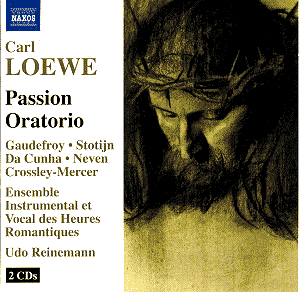Loewe’s Passion
Oratorio followed closely on the
Bach revival in Germany, one which was
powerfully inaugurated by Mendelssohn’s
famous performances of the St Matthew
Passion. Loewe himself performed
Bach’s work two years after Mendelssohn’s
revival performances of 1829 and the
importance of that pioneering work can
be felt throughout his own Passion
Oratorio, which can be provisionally
dated to 1847.
Loewe splits the narrative
amongst his soloists and employs a very
small accompanying force – a string
quintet, to include bass, and an organ.
He sanctioned larger orchestral forces
and also a version for accompanying
solo organ but the version as recorded
here seems to me to have the piquancy
and intimacy of chamber forces allied
to the gently reverential nature of
the piece as a whole. There are certainly
enough incidental string textures to
add variety and colour to the accompanying
passages and where necessary there are
moments of expressive and theatrical
power as well. Pizzicati sharply accompany
Judas’s complaining; the strings interject
strongly in the cry of Blasphemy in
the Trial; there is plenty of strict
contrapuntal writing. The chorales are
simple and effective. Some are derived
from Bach and some from older Lutheran
sources. O Du Zuflucht der Elenden
for instance was originally by Johannes
Crüger and used by Bach in his
Cantata No. 180. And Ach bleib mit
deiner Gnade is a melody by M. Vulius,
taken over and harmonised by Bach for
Cantata 95. One less than convincing
moment is the Chorus of the Daughters
of Sion in Part III – very fey. Nevertheless
the sense of homage and renewal here
is still palpable. There are however
also contemporary stylistic allusions
to Mendelssohn in the romantically descriptive
moments such as Judas’s aria Weh’
mir.
The intimacy of the
chamber forces extends to the choral
as well – a choir of twenty-two. The
choir is resonant and effective but
lacks the ultimate in tonal refinement
and blend. As early as the first Chorale
one can hear them struggle and the sopranos
in particular are somewhat raucous with
individual voices sticking out somewhat
prominently. There’s a very raucous
soprano in the fugal climax of Part
I who does a deal of aural damage to
the proceedings. They all tend to be
a touch florid as well, with vibratos
that tend to over-balance the altos.
Of the soloists three
have studied with the conductor Udo
Reinemann. Soprano Nathalie Gaudefroy
has a very pleasant and well-focused
voice; it’s a touch on the small side
but nicely supported and technically
adroit. Contralto Christianne Stotjin
sounds considerably older than twenty-seven
but contraltos as a breed tend to sound
somewhat more matronly their years.
The voice is a fine one albeit I find
her vibrato, albeit well employed, rather
too wide to match those of her companion
singers. Of late I’ve noticed her taking
on mezzo roles. As compensation she
brings great gravity and seriousness
to her role – try her in Part II’s aria
Heil’ge Nacht.
Tenor Jacky da Cunha
brings plenty of energy if also a certain
amount of strain to his role. Henk Neven
is the most impressive of the quartet
– an eloquent, well-nourished and rounded
voice. Edwin Crossley-Mercer, a bass
from the chorus, takes the small part
of Peter well.
The success of Lowe’s
Passion lies in its simplicity
and compression. At times one can even
imagine oneself listening to chorales
from the St Matthew Passion.
The performance has its rough edges,
as must be acknowledged. It’s also a
live performance, though the audience
is commendably quiet. Only a dropped
programme (or something) alerted me
to its presence, and the applause at
the end. The notes give a synopsis of
the chorales and arias but texts will
need to be downloaded.
The Oratorio offers
a creative sideline on Loewe’s far better
known songs. It faces backwards, as
it were, but with unselfconsciousness.
And it bears with it a surety and sincerity
that are very winning.
Jonathan Woolf
see also review
by Goran Forsling


